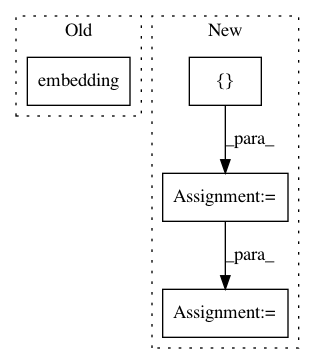db7b74579181f9cbae3583f447d83148714a1c3d,stanza/models/classifiers/cnn_classifier.py,CNNClassifier,forward,#CNNClassifier#Any#Any#,83
Before Change
new_word = word
if new_word in self.vocab_map:
idx = torch.tensor(self.vocab_map[new_word], requires_grad=False, device=device)
input_vectors.append(self.embedding(idx) )
continue
if new_word[-1] == """:After Change
begin_pad_width = random.randint(0, max_phrase_len - len(phrase))
end_pad_width = max_phrase_len - begin_pad_width - len(phrase)
indices = []
unknowns = []
for i in range(begin_pad_width):
indices.append(PAD_ID)
for word in phrase:
// our current word vectors are all entirely lowercased
word = word.lower()
if word in self.vocab_map:
indices.append(self.vocab_map[word])
continue
new_word = word.replace("-", "")
// google vectors have words which are all dashes
if len(new_word) == 0:
new_word = word
if new_word in self.vocab_map:
indices.append(self.vocab_map[new_word])
continue
if new_word[-1] == """:
new_word = new_word[:-1]
if new_word in self.vocab_map:
indices.append(self.vocab_map[new_word])
continue
// TODO: split UNK based on part of speech? might be an interesting experiment
unknowns.append(len(indices))
indices.append(PAD_ID)
for i in range(end_pad_width):
indices.append(PAD_ID)
indices = torch.tensor(indices, requires_grad=False, device=device)
input_vectors = self.embedding(indices)
for unknown in unknowns:
input_vectors[unknown, :] = self.unk
// we will now have an N x emb_size tensor
// this is the input to the CNN
// there are two ways in which this padding is suboptimal
// the first is that for short sentences, smaller windows will
// be padded to the point that some windows are entirely pad
// the second is that a sentence S will have more or less padding
// depending on what other sentences are in its batch
// we assume these effects are pretty minimal
// reshape x to 1xNxE
x = input_vectors.unsqueeze(0)
input_tensor.append(x)
x = torch.stack(input_tensor)
In pattern: SUPERPATTERN
Frequency: 3
Non-data size: 4
Instances Project Name: stanfordnlp/stanza
Commit Name: db7b74579181f9cbae3583f447d83148714a1c3d
Time: 2020-06-15
Author: horatio@gmail.com
File Name: stanza/models/classifiers/cnn_classifier.py
Class Name: CNNClassifier
Method Name: forward
Project Name: analysiscenter/batchflow
Commit Name: 4c50261df4847bdfd7c8067307e8532f96d04104
Time: 2019-08-02
Author: Tsimfer.SA@gazprom-neft.ru
File Name: batchflow/models/torch/encoder_decoder.py
Class Name: EncoderDecoder
Method Name: body
Project Name: dpressel/mead-baseline
Commit Name: 71bd73748b835de5ae20bdc90ce4321e47f4c2b2
Time: 2019-09-25
Author: dpressel@gmail.com
File Name: python/eight_mile/tf/layers.py
Class Name: EmbeddingsStack
Method Name: call
